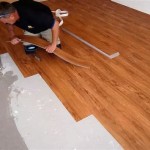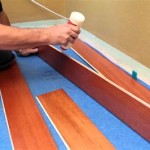Understanding Vinyl Plank Flooring Kits: A Comprehensive Guide
Vinyl plank flooring has gained significant popularity as a resilient, aesthetically versatile, and cost-effective flooring option for both residential and commercial spaces. A critical component of a successful vinyl plank flooring installation is the vinyl plank flooring kit. This article provides a comprehensive overview of vinyl plank flooring kits, outlining their contents, benefits, installation considerations, and maintenance requirements. The purpose is to equip readers with the knowledge necessary to make informed decisions regarding the selection and utilization of these kits.
Vinyl plank flooring, often referred to as LVP (Luxury Vinyl Plank) or LVT (Luxury Vinyl Tile), simulates the appearance of hardwood or stone flooring while offering improved durability and water resistance. Unlike traditional hardwood, vinyl plank is not susceptible to warping, cracking, or staining from moisture exposure, making it suitable for areas like bathrooms, kitchens, and basements. The "plank" format allows for design flexibility, offering various widths and lengths to mimic different wood species and stone textures. The "kit" aspect refers to the grouping of necessary materials beyond just the planks themselves, streamlining the installation process.
What Constitutes a Vinyl Plank Flooring Kit?
While the contents of a vinyl plank flooring kit can vary slightly depending on the manufacturer and the specific product line, there are common components that are typically included. Understanding these components allows for a complete assessment of the kit's suitability for a particular project.
The primary constituent is, of course, the vinyl planks themselves. These are typically sold in boxes or bundles, with each box covering a specified square footage. The quantity of planks within a kit is determined by the intended coverage area. Variations in plank thickness, wear layer, and locking mechanism are significant factors differentiating various kits. Thicker planks generally offer increased durability and a more substantial feel underfoot. The wear layer, a transparent protective coating on the surface of the plank, determines the resistance to scratches, stains, and fading. Locking mechanisms, such as click-lock or tongue-and-groove systems, facilitate the joining of planks during installation.
Underlayment is another common component found in many vinyl plank flooring kits. Underlayment is a thin layer of material placed between the subfloor and the vinyl planks. Its purpose is to provide cushioning, sound absorption, and moisture protection. Some vinyl planks come with pre-attached underlayment, eliminating the need for a separate layer. However, for planks without attached underlayment, the kit often includes rolls or sheets of appropriate underlayment material, correctly sized for the square footage the planks will cover. The type of underlayment included is often dictated by the type of subfloor the planks are meant to be installed over.
Transition pieces are essential for creating a seamless transition between the vinyl plank flooring and adjacent flooring surfaces, such as carpet, tile, or hardwood. These pieces are often included in kits and may consist of T-moldings, reducers, end caps, and stair nosings. The type and quantity of transition pieces included depend on the layout of the room and the types of flooring that will be adjoining the vinyl plank surface. The material used for the transition pieces should match or closely coordinate with the visual characteristics of the vinyl planks.
In some kits, particularly those marketed towards DIY installers, a set of basic installation tools may be included. These tools might comprise a tapping block, a pull bar, spacers, a utility knife, and a measuring tape. While not always comprehensive, these tools can provide a starting point for the installation process. The presence of tools like a tapping block and pull bar is intended to make the interlocking of planks easier and protect them from damage during installation. Spacers maintain a consistent expansion gap around the perimeter of the room, preventing buckling due to temperature and humidity fluctuations.
Adhesives may be included in vinyl plank flooring kits designed for glue-down installations. These adhesives are specifically formulated for bonding vinyl to the subfloor, ensuring a secure and long-lasting bond. The type of adhesive included will depend on the type of subfloor and the specific requirements of the vinyl planks. Proper application of the adhesive is crucial for preventing issues such as bubbling, peeling, or movement of the planks.
Finally, a detailed installation guide is invariably included in a vinyl plank flooring kit. This guide provides step-by-step instructions on how to properly prepare the subfloor, install the underlayment (if applicable), lay the vinyl planks, and install the transition pieces. The guide typically includes diagrams and illustrations to aid in understanding the installation process. Careful adherence to the instructions outlined in the installation guide is essential for achieving a successful and professional-looking installation.
Benefits of Using a Vinyl Plank Flooring Kit
Choosing a vinyl plank flooring kit offers several advantages compared to purchasing individual components separately. These benefits relate to convenience, cost-effectiveness, and assurance of compatibility.
The primary benefit is convenience. Kits provide a one-stop solution, eliminating the need to source individual components from different suppliers. This saves time and effort, particularly for DIY installers who may not be familiar with all the necessary materials. The components are selected to work together seamlessly, ensuring compatibility and avoiding potential issues associated with mixing and matching different brands or product lines. The reduction in shopping around and comparing products simplifies the overall flooring project.
Kits often offer cost savings compared to purchasing individual components separately. Manufacturers can often bundle the materials at a discounted price, making the overall project more affordable. This is especially true for kits that include underlayment, transition pieces, and installation tools. Furthermore, purchasing a kit can help to prevent overspending. By having a pre-determined amount of each component, especially adhesive, waste is minimized and the risk of purchasing excess material is reduced.
Kits ensure compatibility between the various components. The vinyl planks, underlayment (if applicable), and adhesives (if applicable) are selected to work together optimally, ensuring proper adhesion, stability, and performance. This eliminates the risk of using incompatible materials that could compromise the integrity of the flooring. The transition pieces included are also designed to match or complement the vinyl planks, creating a cohesive and visually appealing finished product. The manufacturer's selection of compatible components provides a level of assurance and reduces the likelihood of installation errors.
Kits simplify the installation process, particularly for DIYers. The included installation guide provides clear and concise instructions on how to properly install the flooring. The tools included in some kits can also be helpful for novice installers. The comprehensive nature of the kit reduces the potential for errors and omissions, leading to a more professional and successful installation. Having all the necessary materials readily available also contributes to a smoother and more efficient installation process.
Purchasing a complete kit typically provides a simpler claims process should issues arise with the flooring. If problems occur with the installation or the performance of the flooring, dealing with a single supplier can streamline the process of filing a warranty claim or seeking technical support. This can be particularly beneficial if the problem stems from a defect in one of the components included in the kit or from the interaction between different components.
Key Considerations Before Purchasing and Installing a Vinyl Plank Flooring Kit
Before purchasing and installing a vinyl plank flooring kit, several factors should be carefully considered to ensure a successful outcome. These considerations include assessing the subfloor, determining the appropriate wear layer, and understanding the installation method.
The condition of the subfloor is paramount. The subfloor must be clean, level, dry, and structurally sound. Any imperfections, such as cracks, holes, or unevenness, must be repaired before installing the vinyl plank flooring. Failure to properly prepare the subfloor can result in unevenness, buckling, or premature failure of the flooring. If the subfloor is concrete, it should be free of moisture. If the subfloor is wood, it should be properly secured and free of squeaks or loose boards. Self-leveling compounds and plywood underlayment can be used to address imperfections in the subfloor. Always observe the manufacturer's guidelines for the subfloor preparation requirements.
The wear layer of the vinyl plank is a crucial factor determining its durability and suitability for a particular application. The wear layer is measured in mils (thousandths of an inch). Thicker wear layers offer greater resistance to scratches, stains, and fading. For residential applications with moderate foot traffic, a wear layer of 12 mils or greater is generally recommended. For commercial applications with heavy foot traffic, a wear layer of 20 mils or greater is advisable. Selecting the appropriate wear layer is essential for ensuring the longevity and aesthetic appeal of the flooring.
The installation method is another crucial consideration. Vinyl plank flooring can be installed using various methods, including click-lock, glue-down, and loose-lay. Click-lock installations are generally the easiest for DIYers, as they do not require adhesive. Glue-down installations provide a more secure and permanent bond but require more skill and precision. Loose-lay installations are suitable for temporary or low-traffic areas. The appropriate installation method will depend on the type of vinyl plank flooring, the condition of the subfloor, and the desired level of permanence. It's essential to follow the manufacturer's instructions carefully, regardless of the installation method chosen.
The amount of required material must be carefully calculated. Accurate measurements of the room's dimensions are essential for determining the amount of vinyl plank flooring needed. It's always advisable to purchase extra material to account for waste during installation and potential future repairs. A general rule of thumb is to add 5-10% extra material to the total square footage. This helps to avoid running out of materials midway through the project, especially if intricate cuts or patterns are involved.
Acclimation of the vinyl planks to the environment is necessary. Prior to installation, the vinyl planks should be acclimated to the room's temperature and humidity for at least 48 hours. This allows the planks to expand or contract, preventing issues such as buckling or gapping after installation. The manufacturer's instructions will specify the recommended acclimation period and temperature range. Proper acclimation is critical for ensuring the stability and longevity of the flooring.
Lastly, consider the aesthetics: color, texture, and pattern. The color, texture, and pattern of the vinyl plank flooring should complement the overall design of the room. Consider the existing furniture, wall color, and lighting when selecting the flooring. Samples of the flooring should be obtained and viewed in the room under different lighting conditions to ensure that the color and texture are satisfactory. Careful consideration of these aesthetic factors will contribute to a visually appealing and cohesive finished product.

Lifeproof Pro Installation Kit For Vinyl Laminate And Hardwood Flooring Lp2201 The Home Depot

Lifeproof Pro Flooring Installation Kit For Hardwood Laminate And Vinyl Lp2218 The Home Depot

Workpro Premium Laminate Wood Flooring Installation Kit

Lifeproof Pro Flooring Installation Kit For Hardwood Laminate And Vinyl Lp2218 The Home Depot

Project Source Flooring 4 Pc Installation Kit In The Hard Surface Tools Department At Com

Brutus Pro Installation Kit In The Hard Surface Flooring Tools Department At Com

Installation Kit Flooring At Com

Roberts Pro Flooring Installation Kit

20 Pcs Wood Floor Spacers Flooring Installation Kit Laminate Vinyl Tools Plank Repair Hardwood Com

Wood Floor Tools Pp Vinyl Plank Flooring Installation Kit Repair 31 08 Pic
Related Posts








